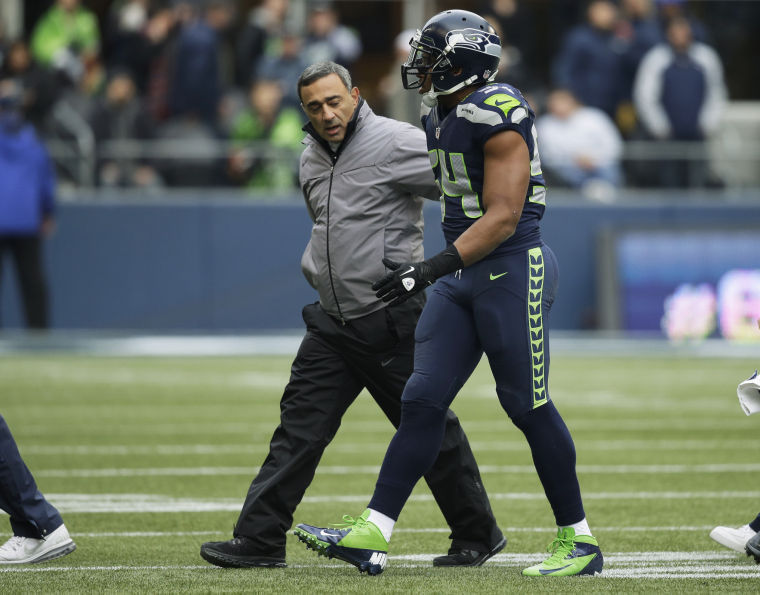Seahawks Keep Team Doctor Busy Year-Round

**A great article written by a newspaper in Dr. Ed Khalfayan’s hometown of Newport in Rhode Island!
Dr. E. Edward Khalfayan, 57 | Head Team Physician, Seattle Seahawks
He is currently the only doctor in America to head the medical staffs of both an NFL and MLB franchise, and has been with the Seahawks since 1996. He has been medical director and team orthopedic surgeon for the Seattle Mariners since 2006. He graduated from Boston College and St. Louis University School of Medicine and completed his residency in orthopedic surgery at the Naval Regional Medical Center in Oakland, California. After fulfilling his military obligation at Marine Corps Base Camp Pendleton he completed a sports medicine fellowship at the University of Pennsylvania’s Graduate Hospital in Philadelphia with the doctors who took care of the Flyers and Eagles before moving to Seattle to start practicing.
You started out as the assistant team physician for the Seahawks and in very little time, you were appointed as the head team physician. How did that happen?
I don’t think I had any respect yet. It was one of those things where I was in the right place at the right time.
People see you on television a lot, but you’re actually part of a larger and often unseen medical team. What kind of medical staffs do NFL teams typically have on hand for game day?
Most teams have a group of physicians. The Seahawks have two orthopedic surgeons, two primary care sports medicine doctors, and one physical medicine and rehab doctor. The Packers probably have the least amount; I think they have three. Some teams have six or seven.
You’re an orthopedic surgeon by specialty. As head team physician, what are your responsibilities?
Ultimately, I’m responsible for overseeing everything, but the primary care doctors take care of general medical issues. The majority of what we do with the team is orthopedic.
What are your medical responsibilities during the season and throughout the year?
It is a full-year thing. Throughout the year, there’s evaluation of free agents, or players whom the Seahawks may be interested in and bring in for a workout and a physical. During the season, there’s game day, and the following day we have injury clinic in the morning. I also make a trip out to the facility during the middle of the week to see players. In the offseason, there are the combines, and then there’s training camp. We’re at practice for the full training camp.
NFL training camps run concurrently with the Major League Baseball season. It must make for a pretty hectic summer.
That’s true. Some days I have to be in both places, but I have help in doing that. It requires a lot of scheduling ahead to coordinate everything.
You work for a team that is motivated to keep big-contract players on the field, but you must provide for player health and safety as well. We’ve seen situations where an organization pressures a player to return too early. How do you navigate the appearance of conflict of interest in gaining player trust?
There is a conflict there, but I think each physician has to resolve that conflict in their own mind. Player agents and the NFL Players Association tell players to always get a second opinion. There’s a basic distrust that’s fostered there, and that’s something that is difficult to fight. My goal is to make sure I take care of the players as I would want to be treated, or have one of my family members treated. That’s the number one priority. Players sense that, and after they’ve been around me they develop that trust. I don’t want to compromise my ethics for the sake of getting a player back out on the field too early. I always try to do the best thing for the player and not necessarily for the team.
The NFL is getting progressively more violent as players hit harder than ever, and new rules are trying to keep pace. Do you think the league will eventually lose the battle in legislating safety?
There’s a very big emphasis on player safety, both from a medical standpoint and also a rules standpoint. I don’t think you can make this game completely safe. It’s not risk-free. I don’t know that we’ll get to the point where we can say that you can go ahead and step out on the field and not have to worry about injury.
The Seahawks’ turnaround began when coach Pete Carroll was hired and built a defense that is among the hardest-hitting in a sport where physical violence is already expected and celebrated. How do you deal with this as a medical professional given this style of play?
You always have to be on your toes. I’ve had the same attitude about it ever since I started under different coaches. The style of play is what it is. We’re always paying attention, watching the field for injuries.
Being head physician for an NFL team may seem like a glamorous position, but the job reportedly has its share of hardships. After 20 years on the job, why do you still do it?
That’s a good question. I think it’s basically because I love doing the job. It’s fun. It does take away time with my family, time at my practice. A lot of time, actually. For a while, every year I asked my wife and kids if they wanted me to keep doing this, and every year they said yes, so I gave up asking. I guess I’ll keep doing this until somebody tells me I can’t.
Written by: Bob Ekstrom | Mercury Link:http://www.newportri.com/newportmercury/off_the_lip/seahawks-keep-team-doctor-busy-year-round/article_6bff7f5e-ff05-5b61-be4a-6bb084b1d0b9.html
For more information on Dr. Khalfayan please visit his personal page, here.
Or visit www.drkhalfayan.comfor more details.
